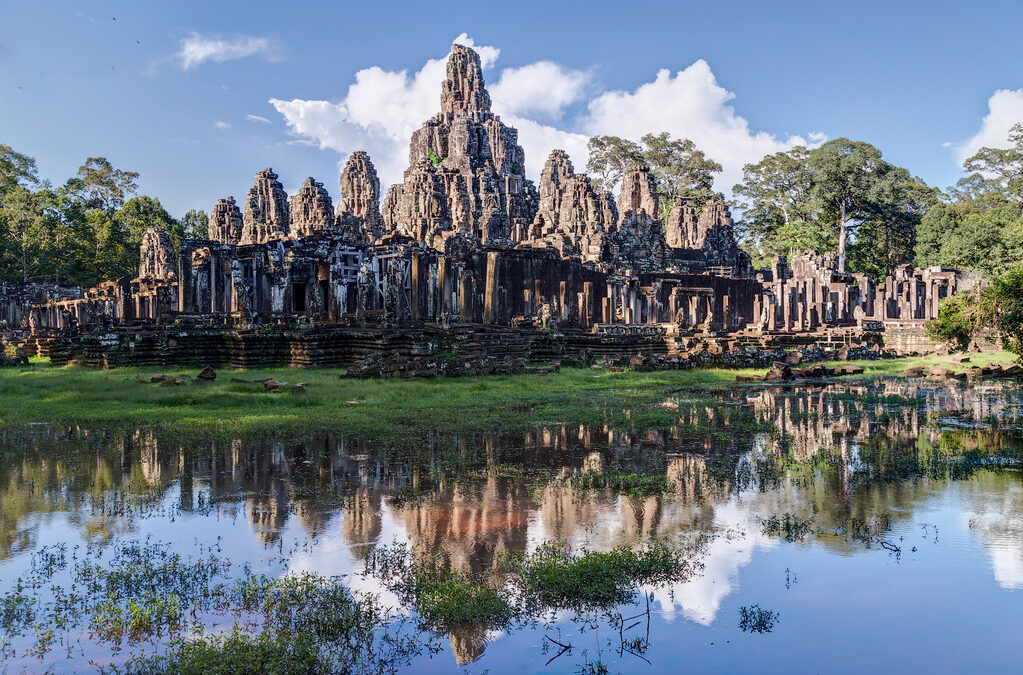In the heart of Cambodia stands Prasat Angkor Wat, a masterpiece of ancient architecture that transcends its original purpose as a 12th-century Hindu temple to become one of humanity’s most remarkable achievements.
Built during the height of the Khmer Empire under King Suryavarman II, this architectural marvel required the efforts of hundreds of thousands of workers and showcases an unprecedented fusion of religious devotion, engineering brilliance, and artistic excellence.
From its innovative construction techniques using millions of tons of sandstone to its evolution from a Hindu sanctuary to a Buddhist shrine, Angkor Wat tells a compelling story of cultural adaptation and resilience.
Today, as Cambodia’s premier national symbol and a UNESCO World Heritage site, the temple complex faces modern challenges of preservation while continuing to captivate millions with its grandeur.
Its journey from a state temple to a global cultural icon reflects not only the rich history of the Khmer civilization but also the enduring power of human creativity and spiritual expression.
Key Takeaways
- Angkor Wat was built in the 12th century during the Khmer Empire under King Suryavarman II.
- The temple complex showcases a blend of Hindu and Buddhist traditions.
- Its architectural design features innovative engineering and construction methods.
- Angkor Wat has evolved into a symbol of Cambodian national identity and a UNESCO World Heritage site.
- Preservation efforts face challenges from environmental degradation, tourism, and urban development.
Historical and Archaeological Perspectives on Prasat Angkor Wat
Archaeological discoveries and primary source documents have revealed intricate details about Prasat Angkor Wat’s construction during the Khmer Empire.
Built under King Suryavarman II in the 12th century, this magnificent temple complex required approximately 300,000-500,000 workers and artisans, who transported more than 5 million tons of sandstone blocks from quarries over 50 kilometers away.
Recent excavation findings indicate sophisticated engineering methods, including the use of specially designed canals and rafts for moving these massive stones.
The temple’s construction timeline spanned roughly 30 years, demonstrating the remarkable organizational capabilities of the Khmer civilization.
Archaeological research has uncovered evidence of the temple’s original dedication to the Hindu deity Vishnu, marking a shift from the previous state temples’ focus on Shiva.
Primary sources, including Chinese diplomat Zhou Daguan’s detailed accounts from the late 13th century, provide valuable insights into the daily religious practices and cultural activities within the temple complex.
These historical records, combined with modern archaeological studies, show how Angkor Wat functioned both as a state temple and a center of political power, featuring intricate administrative systems and religious ceremonies that reflected the sophisticated social structure of the Khmer Empire.
The temple’s orientation, facing west instead of the traditional east, has sparked scholarly debates about its possible function as a funerary temple for Suryavarman II.
Hinduism, Buddhism, and Beyond
The religious landscape of Angkor Wat presents a fascinating study in cultural fusion, where Hindu and Buddhist traditions merged to create a unique spiritual identity.
The temple’s initial consecration to Vishnu gradually evolved during the late 13th century, as Buddhist imagery and symbolism began appearing alongside Hindu elements.
This transformation reflected broader changes in Khmer society, marked by King Jayavarman VII’s promotion of Mahayana Buddhism, which led to the incorporation of Buddhist motifs while maintaining respect for existing Hindu artwork.
The architectural layout maintained its Hindu cosmological design, with the central tower representing Mount Meru, while Buddhist sculptures and inscriptions were integrated throughout the complex.
The spiritual syncretism at Angkor Wat mirrors the fluid religious practices characteristic of Southeast Asian cultures.
Sanskrit inscriptions found within the temple complex document the harmonious coexistence of Hindu and Buddhist worship practices, with both traditions sharing sacred spaces and ritual objects.
This religious flexibility continues to influence modern Cambodian spiritual life, where Hindu deities and Buddhist teachings remain intertwined in local customs and ceremonies.
The temple’s evolution from a Hindu sanctuary to a Buddhist shrine, while preserving its original Hindu architectural symbolism, demonstrates how religious adaptation contributed to its enduring significance in Cambodian cultural identity.
Architectural Innovations and Construction Techniques
The architectural mastery of Angkor Wat stands as a testament to the sophisticated engineering capabilities of the Khmer Empire. The temple complex showcases groundbreaking construction methods, including the use of sandstone blocks fitted without mortar, precise mathematical alignments, and innovative load-bearing techniques.
Research from archaeological studies reveals that builders transported massive stone blocks from quarries over 50 kilometers away, using a network of canals and ingenious pulley systems.
The structural design incorporates graduated towers, galleries, and courtyards that distribute weight effectively, allowing the complex to maintain stability for centuries despite challenging environmental conditions.
The temple’s distinctive features set new standards for religious architecture in Southeast Asia during the 12th century. The main temple structure rises 65 meters high, utilizing a series of stepped platforms and concentric galleries that create an optical illusion of greater height.
Studies of the construction techniques show that Khmer architects developed advanced methods for cutting and placing stones, including the use of mortise and tenon joints, which provided superior structural integrity compared to contemporary building practices.
The complex also incorporated sophisticated water management systems, with moats and reservoirs that served both practical and symbolic functions, demonstrating the builders’ deep understanding of hydraulic engineering principles.
Cultural Symbolism and the Evolution of National Identity
The transformation of Angkor Wat from a state temple into a global cultural icon reflects profound changes in Cambodian society and national consciousness.
The temple’s image on Cambodia’s national flag since 1863 marks its status as the primary symbol of Khmer cultural heritage and sovereignty.
Research from historical records indicates that this shift in symbolic meaning gained momentum during the French colonial period, when archaeological studies and restoration efforts brought international attention to the site.
The temple’s bas-reliefs and architectural elements began to represent not only religious narratives but also became powerful symbols of Khmer artistic achievement and cultural resilience.
The symbolic significance of Angkor Wat has evolved through different historical periods, each layer adding new dimensions to its cultural meaning.
Modern studies of visitor patterns and cultural perceptions show that the temple complex now functions as a multifaceted symbol, representing spiritual heritage, architectural brilliance, and national pride for Cambodians while serving as a focal point for international cultural exchange.
The site’s inscription as a UNESCO World Heritage monument in 1992 formalized its global importance, leading to increased international collaboration in preservation efforts and cultural studies.
This recognition has strengthened both its role in Cambodian national identity and its position as a bridge between ancient and contemporary cultural values.
Conservation Challenges and Preservation Strategies
The preservation of Angkor Wat faces mounting challenges from multiple fronts, requiring sophisticated conservation strategies to protect this architectural masterpiece.
Recent studies by UNESCO and local authorities highlight three primary threats: environmental degradation from climate fluctuations, structural stress from mass tourism, and urban development pressures in the surrounding Siem Reap region.
Research conducted by conservation specialists reveals that groundwater depletion beneath the temple complex has caused concerning settlement issues in certain areas, while increased rainfall intensity has accelerated the weathering of ancient sandstone blocks.
These findings have prompted the implementation of advanced monitoring systems and structural reinforcement techniques.
Modern preservation efforts at Angkor Wat combine traditional craftsmanship with cutting-edge technology to address these challenges effectively.
The APSARA National Authority, working with international conservation teams, has developed a comprehensive preservation framework that includes 3D mapping technology, materials science research, and water management systems.
Scientific analysis of original construction materials has led to the development of specialized restoration techniques that maintain historical authenticity while improving structural stability.
This integrated approach has produced promising results, though experts emphasize that long-term success requires careful balance between preservation needs and tourism demands, supported by sustainable funding mechanisms and continued international cooperation.
Conclusion
Angkor Wat stands as an extraordinary testament to the ingenuity and cultural sophistication of the Khmer Empire.
From its remarkable construction involving hundreds of thousands of workers and innovative engineering techniques to its evolution as a spiritual center that harmoniously blended Hindu and Buddhist traditions, the temple complex represents an unparalleled achievement in human architectural and cultural history.
Its transformation from a state temple to a powerful symbol of Cambodian national identity, coupled with its recognition as a UNESCO World Heritage site, underscores its enduring significance.
However, the site faces contemporary challenges from environmental threats, tourism pressure, and urban development, necessitating careful preservation strategies that combine traditional methods with modern technology.
As we reflect on Angkor Wat’s legacy, several questions emerge: How can modern societies balance the preservation of ancient monuments with the demands of tourism and economic development?
What lessons can we learn from the religious syncretism demonstrated at Angkor Wat about cultural tolerance and adaptation in our increasingly globalized world?
And perhaps most intriguingly, what undiscovered secrets about Khmer civilization might still lie hidden within this magnificent structure’s stones and symbols?



